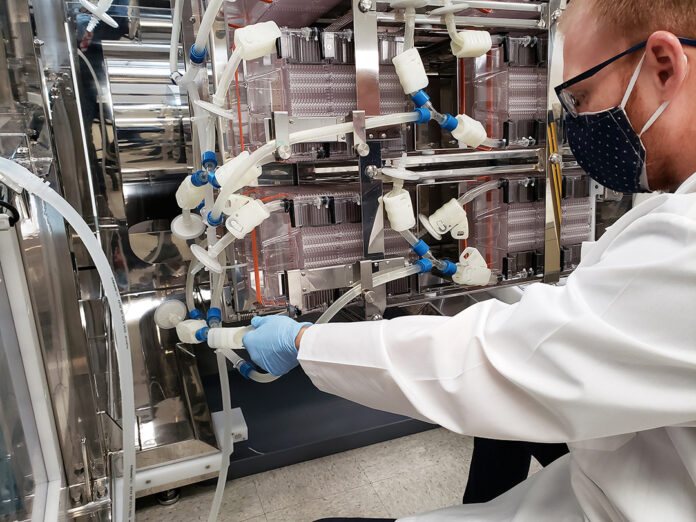
By Tara St.Amand, PhD, and Hannah Gitschier

Drug discovery isn’t driven by luck; in fact, it’s often driven by meticulous planning and preparedness. The success of research is heavily influenced by process decisions made at the beginning of the scientific journey, including choosing which cell culture method is leveraged. New technologies have transformed capabilities in the life sciences, and scientists now have more options than ever to set themselves up for success.
The advancement of personalized medicine and cell and gene therapies has demanded innovation across the industry, calling for customized manufacturing solutions that can meet customer-specific needs. This specificity often requires the ability to tailor cell processing and production methods, and the ability to address the traditional pain points felt by the industry, such as scalability, cell yield, control, and cost efficiency.
Planning for success: Three considerations for cell culture

When choosing a cell production platform, scientists often must decide which pain points are the most crucial to address up front, and which can be managed and adapted to along the way. With careful planning and supplier collaboration, both adherent and suspension platforms can enable project success.
Scalability: The choice between adherent and suspension cell culture platforms can be complex, presenting a variety of factors that need to be considered, including the pathway to scale up and the available resources/labware and lab space.
Naturally, cell culture platform choice will affect scalability and is often influenced by operational and biological factors. Adherent cell culture techniques start in vessels such as flasks and dishes, which serve as entry points for many anchorage-dependent cell types (cells that require attachment to a surface to grow). Perhaps the biggest standout benefit of adherent cell culture is the ease of use and ability to provide anchorage-dependent cell types with biologically relevant surfaces.
However, until recently, this technology did not support scale up that well, requiring manufacturers to scale out with labor-intensive protocols and taking up valuable incubator and cleanroom space. As a result, laboratories often start their processes using adherent culture techniques which are then converted to suspension to support scale up.
Suspension cell culture techniques can range widely in their scale and complexity, from Erlenmeyer and spinner flasks to large-scale stirred-tank bioreactors, making the advantage clear: scale. For manufacturers looking for operational efficiency, suspension platforms are an easy choice. Suspension cultures can produce a high volume of cells (once adapted for the technique, which can be time consuming and biologically challenging) needed for biomedical applications, like monoclonal antibodies.
Suspension platforms can, however, be more challenging in terms of what cells can and how cells must be adapted, potentially impacting cell yield and viability. Many types of cells relevant for biomedical research require attachment to a surface to enable them grow and thrive and to avoid being negatively impacted by shear stress.
Control: Having as much information as possible about culture conditions over time and being able to easily adapt a culture based on that information can often mean the difference between a costly failure and an efficient success.
Being able to identify contamination or quality concerns early, prior to scaling up, can save valuable time, energy, and resources that would have otherwise been wasted or misused. Some adherent platforms offer the benefit of visualization and ease of sampling, allowing easy viewing under a microscope for monitoring and early detection of any issues. These primary advantages, among others, make adherent cell culture vessels the common starting point for researchers involved in primary cell culture and regenerative medicine programs, which tend to involve anchorage-dependent cell types that are subject to spontaneous differentiation and morphology changes.
Suspension cultures lack the ease of direct visualization offered by adherent platforms but often have other built-in process controls that can provide an indication of how the culture is doing. These controls can include the use of sensors and probes and automation of fluid dynamics and gases. Having the ability to automate and control means being able to more closely monitor elements like pH, dissolved oxygen, nutrient and metabolite consumption, and waste output.
However, suspension methods may require more work and time invested up front to optimize and set up process parameters and ensure that adapted cells grow, thrive, produce, and scale in suspension.
Traditionally, suspension platforms offer more opportunities for automation, thus providing more control than adherent platforms; however, new adherent bioreactor technologies are enabling adherent-based culture with increased automation, sensing, and control.
Cost: Adherent and suspension cell culture techniques each come with their own considerations with regard to investment, which is highly variable depending on the process being implemented. There are many aspects of cost to consider when designing an experiment or process. Decisions regarding cell culture technique heavily impact the cost required both up front and throughout the experiment or process. Desired outcomes, scale, and flow of available capital may also dictate where and when investment is made.
Costs can come in the form of labor, consumables, and quality assurance investments, all of which are very much dictated by the type and scale of process implemented. Additionally, the available space in the facility plays a large role when considering the purchase of large capital equipment, thus also affecting decisions that may impact cost.
Maximizing the benefits of each technique
New technologies look to maximize the benefits of each respective technique so that researchers have the greatest level of flexibility available to them when designing experiments and processes. Areas for growth are available in both adherent and suspension techniques, including incorporating more automation and reducing the footprint for adherent cell culture, and minimizing shear stress (force exerted on the cells) and optimizing cell culture for suspension.
The need for scalable, adherent technologies that can increase manufacturing capacity has been a driving force within the industry, propelled by the growing demand for advanced therapeutics, such as cell and gene therapies. One such technological advancement is the Corning® AscentTM Fixed Bed Reactor (FBR), which allows for more automated control and scale with an adherent-based cell culture platform. The bioreactor is designed to combine the benefits of adherent bioproduction platforms with the scale and automation of suspension manufacturing systems, offering automation with regard to many aspects of cell culture, including monitoring, gassing, and cell harvest.
Equipment vendors or consumable manufacturers are relied upon not only to provide the materials and solutions needed, but also to support scientists at all stages of research and production. By collaborating with industry, manufacturers are working to adapt and develop products that meet the current needs of the scientific community. Corning’s Ascent FBR was developed through a similar process: listening to customers’ needs and problem-solving for those who wanted to scale up with control in an adherent-based platform.
Additionally, equipment vendors can help customize a process from end to end. This can include providing closed system solutions, devising custom configurations, or developing new products that help fill workflow gaps.
Looking to the future
The shift toward more complex therapeutics is rapidly changing manufacturing needs. As science progresses, projected forward by recent rapid advancements, such as mRNA for COVID-19 vaccine efforts, innovation in technology and equipment must keep pace. We must continue to advance capabilities in control, monitoring, specialized surfaces, and tunability, all while minimizing things like cost and equipment footprint to drive efficiency.
Adherent and suspension cell culture platforms each come with their own pros and cons, but there are opportunities to get the best out of both worlds with careful planning. Choices in cell culture equipment have a direct impact on success, influencing how and when important innovations, like advanced therapeutics, are brought to market. The types of therapies we rely on each day to save lives are advancing, and so too must the technologies that scientists use when manufacturing those therapies.
Tara St.Amand, PhD, MBA is Director, Business Technology, Bioprocess and Hannah Gitschier, MS is Development Manager, Advanced Cell Culture, Corning Life Sciences.




